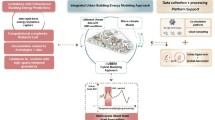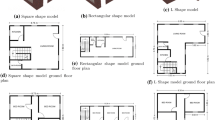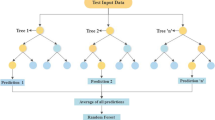Abstract
Occupant-controlled window opening plays a significant role in exposure to indoor environmental hazards such as high temperatures and PM2.5. Both the indoor and outdoor environments can affect window opening behaviour of building occupants, while variation in this behaviour is often poorly defined in building simulations. This study examines the robustness of six existing behavioural models of window opening in predicting window-use patterns in Hong Kong flats, and the impact of behavioural models on the accuracy of indoor temperature and indoor PM2.5 concentration prediction. The behavioural models were implemented in the EMS application of EnergyPlus. The predicted window-use patterns were compared to those of filed measurements, whilst the predicted indoor temperatures and indoor PM2.5 concentrations were benchmarked against those predicted by the EnergyPlus model with the actual occupant window opening behaviour. Results indicate that the ability of individual behavioural models to accurately predict occupant window opening behaviour varies depending on modelling approach, outdoor environmental variable and simulation time-step size. The model providing the best estimate of the duration of window-opening is able to best contribute to accurate predictions about indoor temperatures and indoor PM2.5 concentrations. Results also show that a static temperature threshold for window-opening (a common method of modelling occupant window opening behaviour) can lead to a significant difference between the actual and predicted window-use patterns (and therefore indoor temperatures or indoor PM2.5 concentrations), underlining the importance of improving model inputs for occupant window opening behaviour.
Similar content being viewed by others
References
Ai ZT, Mak CM, Cui DJ, Xue P (2016). Ventilation of air-conditioned residential buildings: A case study in Hong Kong. Energy and Buildings, 127: 116–127.
Andersen R, Fabi V, Toftum J, Corgnati SP, Olesen BW (2013). Window opening behaviour modelled from measurements in Danish dwellings. Building and Environment, 69: 101–113.
Andersen RK, Fabi V, Corgnati SP (2016). Predicted and actual indoor environmental quality: Verification of occupants’ behaviour models in residential buildings. Energy and Buildings, 127: 105–115.
Borgeson S, Brager G (2008). Occupant control of windows: Accounting for human behavior in building simulation. CBE Internal Report. Center for the Built Environment.
Cali D, Andersen RK, Muller D, Olesen BW (2016). Analysis of occupants’ behavior related to the use of windows in German households. Building and Environment, 103: 54–69.
Chan L, Kwok W (2000). Vertical dispersion of suspended particulates in urban area of Hong Kong. Atmospheric Environment, 34: 4403–4412.
CIBSE (2006). CIBSE guide A. Environmental design. Chartered Institution of Building Services Engineers (CIBSE).
Crawley DB, Lawrie LK, Winkelmann FC, Buhl WF, Huang Y, et al. (2001). EnergyPlus: creating a new-generation building energy simulation program. Energy and Buildings, 33: 319–331.
Dimitroulopoulou C, Ashmore MR, Hill MTR, Byrne MA, Kinnersley R (2006). INDAIR: A probabilistic model of indoor air pollution in UK homes. Atmospheric Environment, 40: 6362–6379.
Fabi V, Andersen RV, Corgnati S, Olesen BW (2012). Occupants’ window opening behaviour: A literature review of factors influencing occupant behaviour and models. Building and Environment, 58: 188–198.
Fabi V, Andersen RK, Corgnati S (2015). Verification of stochastic behavioural models of occupants’ interactions with windows in residential buildings. Building and Environment, 94: 371–383.
Fritsch R, Kohler A, Nygard-Ferguson M, Scartezzini JL (1990). A stochastic model of user behaviour regarding ventilation. Building and Environment, 25: 173–181.
Gunay HB, O’Brien W, Beausoleil-Morrison I (2016). Implementation and comparison of existing occupant behaviour models in EnergyPlus. Journal of Building Performance Simulation, 9: 567–588.
Gunay HB, O’Brien W, Beausoleil-Morrison I, Gilani S (2017). Development and implementation of an adaptive lighting and blinds control algorithm. Building and Environment, 113: 185–199.
Haldi F, Robinson D (2008). On the behaviour and adaptation of office occupants. Building and Environment, 43: 2163–2177.
Haldi F, Robinson D (2009). Interactions with window openings by office occupants. Building and Environment, 44: 2378–2395.
Haldi F, Robinson D, Proglhof C, et al. (2010). A partial double blind evaluation of a comprehensive window opening model. In: Proceedings of BauSIM 2010 Conference, pp. 331–336.
Herkel S, Knapp U, Pfafferott J (2008). Towards a model of user behaviour regarding the manual control of windows in office buildings. Building and Environment, 43: 588–600.
Jones N, Thornton C, Mark D, Harrison R (2000). Indoor/outdoor relationships of particulate matter in domestic homes with roadside, urban and rural locations. Atmospheric Environment, 34: 2603–2612.
Jones B, Das P, Chalabi Z, Davies M, Hamilton I, et al. (2013). The effect of party wall permeability on estimations of infiltration from air leakage. International Journal of Ventilation, 12: 17–30.
Jones RV, Fuertes A, Gregori E, Giretti A (2017). Stochastic behavioural models of occupants’ main bedroom window operation for UK residential buildings. Building and Environment, 118: 144–158.
Lai HK, Bayer-Oglesby L, Colvile R, Gotschi T, Jantunen MJ, et al. (2006). Determinants of indoor air concentrations of PM2.5, black smoke and NO2 in six European cities (EXPOLIS study). Atmospheric Environment, 40: 1299–1313.
Long CM, Suh HH, Catalano PJ, Koutrakis P (2001). Using time- and size-resolved particulate data to quantify indoor penetration and deposition behavior. Environmental Science & Technology, 35: 2089–2099.
Mavrogianni A, Wilkinson P, Davies M, Biddulph P, Oikonomou E (2012). Building characteristics as determinants of propensity to high indoor summer temperatures in London dwellings. Building and Environment, 55: 117–130.
Nicol JF, Humphreys MA (2004). A Stochastic approach to thermal comfort-occupant behavior and energy use in buildings. ASHRAE Transactions, 110(2): 554–568.
O’Brien W, Gunay HB (2014). The contextual factors contributing to occupants’ adaptive comfort behaviors in offices—A review and proposed modeling framework. Building and Environment, 77: 77–87.
Parys W, Saelens D, Hens H (2011). Coupling of dynamic building simulation with stochastic modelling of occupant behaviour in offices - a review-based integrated methodology. Journal of Building Performance Simulation, 4: 339–358.
Peacock AD, Jenkins DP, Kane D (2010). Investigating the potential of overheating in UK dwellings as a consequence of extant climate change. Energy Policy, 38: 3277–3288.
Rijal HB, Tuohy P, Humphreys MA, Nicol JF, Samuel A, Clarke J (2007). Using results from field surveys to predict the effect of open windows on thermal comfort and energy use in buildings. Energy and Buildings, 39: 823–836.
Rijal HB, Tuohy P, Humphreys MA, Nicol JF, Samuel A (2012). Considering the impact of situation-specific motivations and constraints in the design of naturally ventilated and hybrid buildings. Architectural Science Review, 55: 35–48.
Roetzel A, Tsangrassoulis A, Dietrich U, Busching S (2010). A review of occupant control on natural ventilation. Renewable and Sustainable Energy Reviews, 14: 1001–1013.
Schweiker M, Haldi F, Shukuya M, Robinson D (2012). Verification of stochastic models of window opening behaviour for residential buildings. Journal of Building Performance Simulation, 5: 55–74.
Shi S, Zhao B (2016). Occupants’ interactions with windows in 8 residential apartments in Beijing and Nanjing, China. Building Simulation, 9: 221–231.
Taylor J, Shrubsole C, Davies M, Biddulph P, Das P, et al. (2014). The modifying effect of the building envelope on population exposure to PM2.5from outdoor sources. Indoor Air, 24: 639–651.
Yao M, Zhao B (2017). Window opening behavior of occupants in residential buildings in Beijing. Building and Environment, 124: 441–449.
Zhang N, Jin W, He J (2016). Experimental study on the influence of ventilated window on indoor air quality and energy consumption. Procedia Engineering, 146: 296–302.
Zhang T, Su Z, Wang J, Wang S (2018). Ventilation, indoor particle filtration, and energy consumption of an apartment in Northern China. Building and Environment, 143: 280–292.
Acknowledgements
This work was supported by City University of Hong Kong through the UGC-allocated funds and TA scheme (Grant No. 000618).
Author information
Authors and Affiliations
Corresponding author
Electronic Supplementary Material
12273_2020_615_MOESM1_ESM.pdf
Verification of behavioural models of window opening: The accuracy of window-use pattern, indoor temperature and indoor PM2.5 concentration prediction
Rights and permissions
About this article
Cite this article
Zhong, X., Ridley, I.A. Verification of behavioural models of window opening: The accuracy of window-use pattern, indoor temperature and indoor PM2.5 concentration prediction. Build. Simul. 13, 527–542 (2020). https://doi.org/10.1007/s12273-020-0615-4
Received:
Revised:
Accepted:
Published:
Issue Date:
DOI: https://doi.org/10.1007/s12273-020-0615-4




